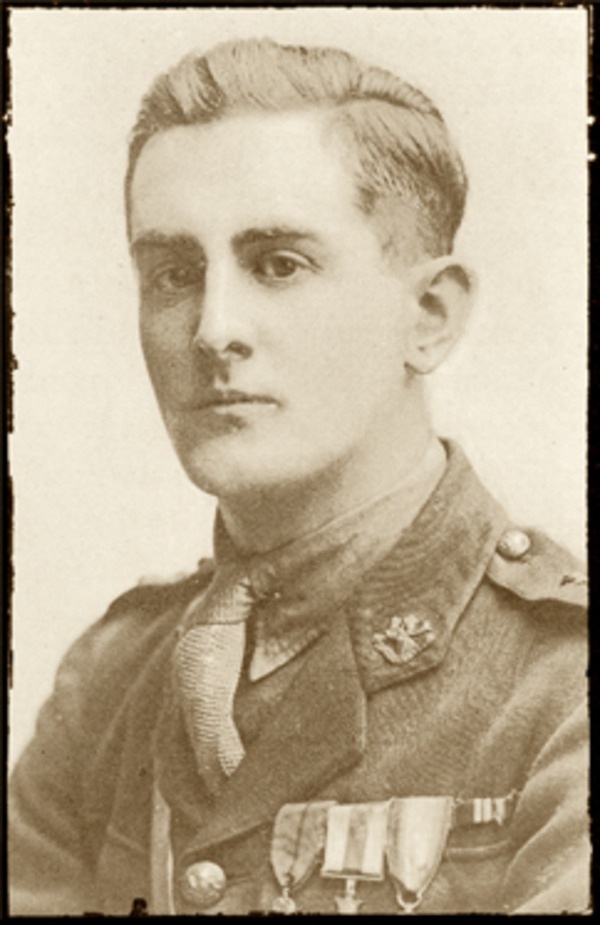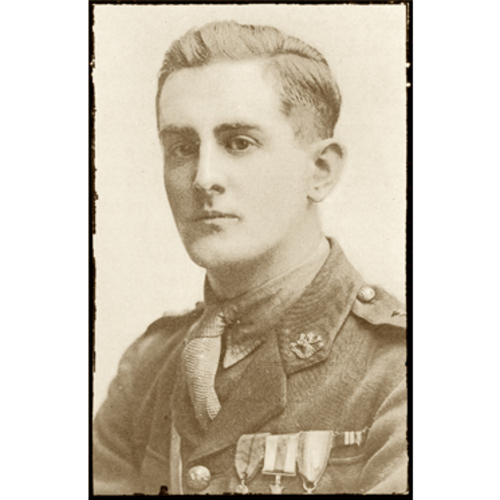
Source: Link
WHITTY, GERALD JOSEPH, army officer and veterans’ official; b. 25 Aug. 1896 in St John’s, son of John Whitty and Catherine Dwyer; d. unmarried 15 Sept. 1924 in nearby Donovans.
The Whittys were of Irish descent and typified rank-and-file Roman Catholic life in the St John’s of the period. Gerald (Jerry) Whitty worked for the Reid Newfoundland Company from August 1908 to 24 Dec. 1914, when he enlisted in the Newfoundland Regiment. He trained as a signaller and in September 1915 was sent to Gallipoli (Gelibolu, Turkey). There he contracted enteric fever and suffered a groin strain. Evacuated first to Malta, he was later sent to England, where he was promoted second lieutenant on 1 Nov. 1916. His enlistment and rise through the ranks highlight the social mobility that the war brought to many young Newfoundlanders and the mobilization of Roman Catholics in a common cause with Protestants. Eventually, the war produced deep social and political divisions in Newfoundland, but it also blurred denominational lines and created new institutions with broad popular appeal. Whitty’s life exemplifies these elements.
In June 1917 Whitty went to France. Blown into the Yser Canal in Flanders on 25 July, he suffered eye and nose injuries but remained at the front. In the battle of Cambrai he led a charge on 20 Nov. 1917. He was shot in the shoulder and for his heroism was awarded the Military Cross. In July 1918 he was made acting captain (he had now learned to fly) and on 3 June 1919 he became an officer of the Order of the British Empire (military division).
Whitty arrived back in St John’s on 1 July 1919 and was demobilized on the 29th. Like many ex-servicemen, he faced a difficult transition. After disappointing forays to New York and Montreal, he retreated to St John’s where he worked temporarily for Reid Newfoundland. On 18 Feb. 1920 he became a member of the Civil Re-establishment Committee, which the Newfoundland government had set up on 25 June 1918 to assist veterans to find their way in civilian life. Eventually, in the late summer of 1920, he found lasting employment as secretary-treasurer (later dominion secretary) of the Great War Veterans’ Association of Newfoundland. The GWVA had originated in the Soldiers and Rejected Volunteers Association, formed in St John’s on 11 April 1918. On 20 Aug. 1918 this association had refashioned itself along the lines of the Great War Veterans’ Association of Canada, established in 1917. The GWVA in both countries was an assertive organization whose brief was written in blood. Whitty’s work as secretary-treasurer was multifarious and built upon his work in civil re-establishment. He helped run the poppy campaign, begun in 1921, and edited the Veteran Magazine, first published in December 1920. In 1923 he represented the GWVA in London at the first biennial conference of the British Empire Service League.
Two issues dominated the affairs of the GWVA in the early 1920s: the improvement of pensions and the project of a national memorial to honour Newfoundland’s war dead. Whitty played a prominent role in both matters. Pensions for veterans and their dependants had been approved by the government in 1917 with payments subject to annual adjustments. When the latter were not forthcoming, the GWVA lobbied hard for redress and made significant gains. The organization was likewise successful in the war memorial project. Under the leadership of former Newfoundland Regiment padre Father Thomas F. Nangle and Whitty, the GWVA conducted a public fund-raising campaign for the monument, which was situated at King’s Beach, St John’s. Whitty organized the ceremony on 1 July 1924 at which Field-Marshal Earl Haig unveiled the memorial.
Two months later Newfoundland was visited by the Special Service Squadron of the Royal Navy. St John’s celebrated the visit appropriately. On the evening of 15 September, while the pleasantries were in progress, Whitty and 13 companions met in a restaurant at Donovans to bid farewell to a friend who was leaving for England. At 11:00 p.m., he, William King, another prominent Newfoundland veteran, and Chief Petty Officer Robert Lovett of hms Constance were standing by the bus that was to take the party back to St John’s. Suddenly, a speeding car appeared and struck the three men. Whitty and King were killed instantly, as were four occupants of the car, including two other officers from the Constance. The driver was Leonard Reid, the son of Sir William Duff Reid. In November he would be convicted of manslaughter and sentenced to one year in the penitentiary.
Following the civic triumphs of the unveiling of the National War Memorial and the arrival of the Special Service Squadron, the accident cast a gloom. On 18 September, St John’s became a “city of funerals.” In the afternoon, following the burial of King in the General Protestant Cemetery, the funeral procession continued to Whitty’s residence. From there, a guard of honour from the Catholic Cadet Corps escorted the captain’s casket east along Water Street. At the war memorial a short halt was made and wreaths placed. Whitty was buried in Belvedere Cemetery, among the Irish Catholic prominenti of St John’s, whose ranks, thanks to service in war and its aftermath, he had risen to join. At the graveside, Father Nangle observed that veterans had lost “their best friend and advocate.”
The authors are grateful to Mr Gerald Penney of St John’s for making available his collection of the Veteran Magazine (St John’s) for the period 1920–24.
Arch. of the Royal Canadian Legion, Newfoundland and Labrador Command, Branch 56 (St John’s), Minute-book of the Soldiers and Rejected Volunteers Assoc., 1918–20. NA, RG 38, A-2-e, 489: 0-188. PANL, GN 2/39/A, 1921, St John’s West (mfm. at Centre for Newfoundland Studies, Memorial Univ. of Nfld, St John’s); GN 8/2; MG 592; MG 632. Daily News (St John’s), 1914–24. Evening Advocate (St John’s), 1916–24. Evening Telegram (St John’s), 1914–24. St. John’s Daily Star, 1918–20. Desmond Morton and Glenn Wright, Winning the second battle: Canadian veterans and the return to civilian life, 1915–1930 (Toronto, 1987). P. [F.] Neary, “Democracy in Newfoundland: a comment,” Journal of Canadian Studies (Peterborough, Ont.), 4 (1969), no.1: 37–45; “How Newfoundland veterans became Canadian veterans: a study in bureaucracy and benefit,” in Twentieth-century Newfoundland: explorations, ed. J. [K.] Hiller and P. [F.] Neary (St John’s, 1994), 195–237. Nfld, Acts, 1916–24; House of Assembly, Journal, 1919, app. “Report of the Civil Re-establishment Committee up to April 26th, 1919”. Newfoundland Quarterly (St John’s), 1914–24. G. W. L. Nicholson, The fighting Newfoundlander: a history of the Royal Newfoundland Regiment (St John’s, [1964]). P. R. O’Brien, “The Newfoundland Patriotic Association: the administration of the war effort, 1914–1918” (ma thesis, Memorial Univ. of Nfld, St John’s, 1981).
Cite This Article
Melvin Baker and Peter Neary, “WHITTY, GERALD JOSEPH,” in Dictionary of Canadian Biography, vol. 15, University of Toronto/Université Laval, 2003–, accessed January 10, 2026, https://www.biographi.ca/en/bio/whitty_gerald_joseph_15E.html.
The citation above shows the format for footnotes and endnotes according to the Chicago manual of style (16th edition). Information to be used in other citation formats:
| Permalink: | https://www.biographi.ca/en/bio/whitty_gerald_joseph_15E.html |
| Author of Article: | Melvin Baker and Peter Neary |
| Title of Article: | WHITTY, GERALD JOSEPH |
| Publication Name: | Dictionary of Canadian Biography, vol. 15 |
| Publisher: | University of Toronto/Université Laval |
| Year of publication: | 2005 |
| Year of revision: | 2005 |
| Access Date: | January 10, 2026 |



